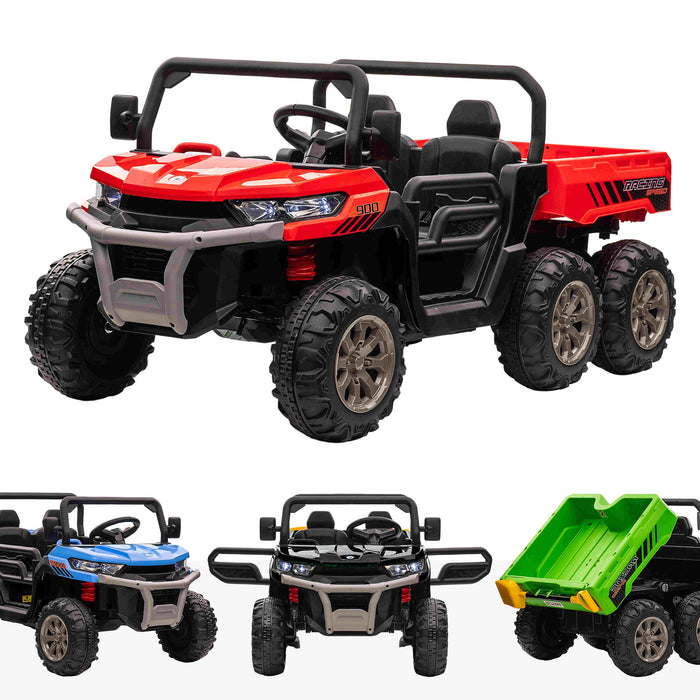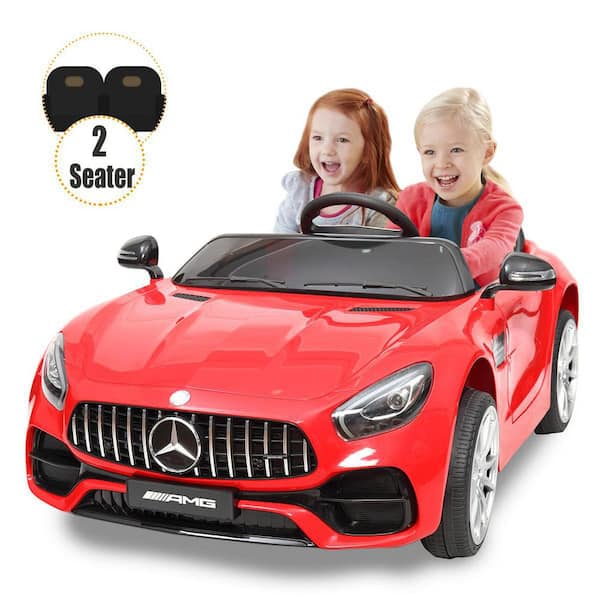Top Advice To Selecting Remote Control Childrens Cars
Top Advice To Selecting Remote Control Childrens Cars
Blog Article
What Features Of A Ride-On Car Should I Be Looking At? Pros And Cons
If you are considering a ride-on automobile for your child Safety features are essential to ensure that they are safe during playtime. Seat Belts and other safety features are essential.
Pros: Seat belts protect your child from the ride-on vehicle, reducing the chance of them falling out or getting kicked out of the car in the course of play. They offer an extra layer of protection, especially when turning or making sudden stops.
Cons - Some cars with ride-ons might not have seat belts, specifically those made for children younger than. Seat belts can be uncomfortable to children and cause them to resist wearing them.
Sturdy Construction -
Pros - A ride-on car that is built with strength and high-quality materials is more durable and resistant to damage that ensures long-term safety and dependability. It's built to last long enough to withstand the strains of playing while also providing stability.
Cons - The cost of a sturdy construction can be costly, making them prohibitive for many families. The ride-on cars may also be less mobile and maneuverable if they are made of heavier materials.
Low Center Of Gravity
Pros: Vehicles with a low centre of gravity are prone to a less likelihood of tipping over. This decreases the risk of an accident or injury. They provide greater stability and better balance, especially in turning and maneuvers.
Pros - Certain rides-on-cars that have lower centers of gravity can sacrifice their off-road ability or their ground clearance. This limits their versatility in certain conditions.
Remote Control for Parents -
Pros: Remote-controlled cars allow parents to monitor and supervise their child's playing, adding an extra layer of control and safety. Parents can intervene to avoid accidents, navigate difficult terrain, and help their child in the event of a crisis.
Cons Parents who control their children's remotes could restrict the independence and autonomy of children, since they depend on their parents' assistance and direction during play. Furthermore, the cost of ride-on vehicles controlled by remotes can be higher than that of the manual versions.
Speed Limiters
Pros - Ride on vehicles with adjustable speeds or speed limiters permit parents to set the maximum speed for the car. This decreases the chance of accidents and collisions. The parents can increase the speed of their ride-on car as their child becomes more confident and proficient.
Cons - Some kids might get used to the slower speeds very quickly, leading to frustration and dissatisfaction. Speed limiters are not always available on every model or they may require extra features or accessories.
Safe Start Technology -
Pros: Safe start guarantees smooth stops and starts of the ride on car which reduces the danger of sudden jerks or movements which could frighten a child or cause them to lose their balance. This ensures a safer and more enjoyable ride.
Cons: Ride-on vehicles equipped with safe-start features may be more expensive than standard models. Additionally, children may find that gradual acceleration and deceleration are not as entertaining or enjoyable than rapid beginnings and stops.
Visibility Enhancements
Pros - Ride-on vehicles equipped with enhancements to visibility, such as functioning taillights, headlights or reflective material improve visibility, particularly in low-light conditions or in dimly lit areas. They improve safety as they help make the vehicle more visible to other vehicles or pedestrians.
Cons - The greater visibility may result in the battery draining faster, or add the complexity of the design. This can increase the chance of issues or maintenance.
If you take a look at these safety features, and weighing their pros and cons you can choose a ride-on car that prioritizes your child's safety and provides a fun and enjoyable play experience. Take a look at the most popular McLaren kids car for more advice including ride a toy, toy with car, toy a car, electric ride along car, car for toy, childrens ride on, toy a car, kids electric cars, ride a toy, ride electric car and more. . 
How Do You Maintain And Put Together A Child's Ride-On Vehicle?
For optimal performance, safety and durability kids' ride-on vehicles require some form of assembly. Here are some typical assembly and maintenance needs for kids' ride-on vehicles:
The majority of ride-on cars are partially assembled at the time of arrival and require some sort of assembly. Connecting steering wheels, wheels, seats, and other components as in accordance with the specifications supplied by the manufacturer are usually required.
Please follow the directions for assembly carefully to make sure that all components are correctly aligned and attached. Make use of the tools and hardware included to complete the procedure.
Cleaning -
It is essential to wash the vehicle's ride-on regularly in order to maintain its appearance and function. Use a soft cloth or sponge dampened with mild soap and water to wash down the exterior surfaces getting rid of dust, dirt and debris.
Be aware of places that are prone to accumulation, such as the wheels, tires, and undercarriage. To remove stubborn dirt and grime make use of a toothbrush or brush to reach places that are difficult to reach.
Avoid using harsh chemical cleaners, abrasive chemicals, or high-pressure water sprays since they could harm the electronic or paint components of the ride-on automobile.
Battery Care
It is crucial to take care of the battery in case your ride-on vehicle is powered by a battery which can be recharged. This will help you maintain its performance and extend the life of your battery. Use these battery care guidelines to help you maintain your battery's health.
Fully charge the battery prior to first use and after each use to ensure maximum runtime.
Avoid overcharging or allowing the battery to be connected to the charger for prolonged time, as this could cause damage to the battery and decrease the battery's lifespan.
When not in operation Keep the battery and ride-on cars in a place which is cool and dry and free of intense temperatures and direct sunlight.
Check the battery terminals periodically for damage or corrosion. Clean them as required using the help of a wirebrush or a terminal cleaner.
Replace it if the battery is not able to hold a full charge or has evidence of damage or deterioration.
Tire Maintenance -
Regularly check your tires for signs like wear, damage or decrease in air. Make use of a bicycle compressor or air compressor to fill the tires to the pressure recommended by the manufacturer.
Check the tread pattern and see whether there are any foreign objects or particles that could cause flats and punctures. Clear any obstructions and replace or repair damaged tires if necessary.
Lubricate the wheel bearings and axles at regular intervals to lessen friction.
Periodic replacements or repairs
Ride-on vehicles may require repair or replacement of parts due wear or damage.
Check for indicators of malfunction, such as unusual noises, a decrease in power, or an unsteady performance. Refer to the manufacturer's guidelines or contact Customer Support to assist in troubleshooting.
To avoid further damage replace worn-out or damaged components as soon as you can to ensure the safety of your equipment and its functionality.
If you follow these assembly and maintenance guidelines by following these guidelines, you can keep your child's ride-on vehicle in top condition and enjoy hours of fun and safe time with your child. View the top rated go here for kids cars for site examples including car toy toy, ride electric car, kidscars, electric ride on, toy and car, electric ride along car, ride of car, electric two seater cars, ride electric car, ride electric car and more. . 
What Should I Think About Prior To Buying An Electric Car For My Child? What Are Pros And Con?
Be aware of these aspects before buying an electric car for your child to ensure you purchase the most suitable option to fit your child's needs. Here are some key considerations, along with information on sizes, prices pro and cons The age and size of the Child
Choose an electric kid's car depending on the size and age of your child. Children who are smaller and less seasoned may prefer compact and lightweight models, whereas older and larger children may require larger vehicles with larger spaces to seat them comfortably.
Car Size and Weight -
Models for electric cars for kids are available in a variety of sizes. From small-scale to larger-scale replicas, they're available. Take into consideration the weight and size of the vehicle in relation to your child's age, size and strength, as well as the amount of space for storage and playing.
Price Range Price Range
The cost of electric vehicles for children can be a bit different dependent on a variety of factors, including the size, model and the quality. Prices range from $50-200 for micro-sized replicas, while higher-end licensed replicas cost $200-800.
Pros and cons -
Pros -
Children's electric cars offer endless hours of fun, imaginative play and the chance to drive their own vehicle.
Motor Skill Development - Operating an electric car helps children to develop coordination, spatial awareness, and fine motor skills.
Outdoor Play - Electric cars encourage outdoor play and physical activity, promoting exercise and exploration.
Realistic Features: A lot of electric cars for children come with realistic features such as working lights, horns, and MP3 playability. This makes for a more enjoyable playing experience.
Cons
Cost - Electric kids' automobiles, especially licensed replicas of brands, can be expensive.
Battery Life - Electric vehicles depend on rechargeable batteries for power. These batteries can have limited run time and require frequent recharge.
Safety Risks - Electric vehicles may pose safety concerns such as falls, collisions, and entrapment, if not handled with caution and under adult supervision.
Maintenance and Assembly – Certain electric cars will require assembly prior to the time when they arrive. They might also require regular maintenance, such as cleaning, battery treatment and repairs or replacements of parts.
Features and Accessories -
Check out the available features and accessories available for your electronic kids' vehicles with horns that operate as well as storage compartments, seatbelts, and parental remote controls. Pick a car with features that are suitable for your child's preferences and interests.
In the end, the ideal electric car for your child will depend on factors such as their age, size, interests, and your budget. Do your research to compare models as well as read reviews, then weigh up the pros & pros before deciding. See the most popular kids ride on cars kidscars.co.uk advice for website recommendations including car toy car toy, ride ons, remote control childrens car, a toy car, toy a car, childrens electric cars, ride of car, ride on toy, toy toy cars, a toy car and more. .